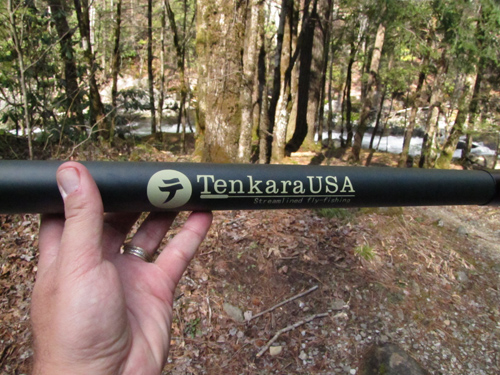Yesterday Charity and I took two new Tenkara rods out for the afternoon in the Smokies. We’ve been pretty curious for a while but finally pulled the trigger. Everything we’ve ever read about Tenkara touts its simplicity, and that is almost an understatement.
There is very little to do in the way of set up since there is no reel or fly line. We took two rods, a 13′ Ayu and a 12′ Iwana and used to different style leaders. The first leader was the furled style with a few feet of tippet material. This rig cast beautifully on both rods but was a little long for the area we were fishing.
We made leaders with Tenkara level line, nothing more than hard monofilament and added some tippet material. As light as this was the rods still cast the flies very nicely and accurately. I can say with complete confidence that anyone who can fly cast will find Tenkara very easy to pick up. It’s probably easier for those who have never fly fished, but like a fly rod, Tenkara demands a light touch.
We fished with both dry flies and nymphs. As you might expect, the nymphs did better since it’s January, but Charity did hook a fish on an Elk Caddis. There were good numbers of Early Brown Stoneflies laying eggs on the water and Charity found one enthusiastic riser to take her fly.
Our only problem came when it was time to land fish, and it was primarily because of our inexperience with these long rods. Every time we hooked a fish we hung the rods in overhanging branches. We’ve used 8′-9′ fly rods on these streams as long as we can remember and are accustomed to keeping them out of the trees. The extra few feet was no problem during casting, just during the excitement of hooking fish.
I can tell these rods will work superbly on larger trout streams around the Smoky Mountain region like Little River, Tellico River, Deep Creek and others. Tight streams like Jake’s Creek, Little Cataloochee, and Chasteen Creek that flow through rhododendron tunnels are probably not well suited for this. These streams are tight enough to challenge most fly fishers with much shorter rods and require a fair number of bow and arrow casts. I’m sure we’ll eventually become very comfortable handling fish on these longer rods, but for now we’re going to stick to the bigger waters to gain some experience.
I am very excited to try Tenkara in a number of spots, though. The extra rod length coupled with the all monofilament line will make it much easier to achieve a good drift in countless locations. It also allows you to stay further back from the fish in pocket water like we have in the Smokies. The ultra light, extra sensitive tips on these rods also make them excellent for tight line nymphing or wet flies. Even those who have always relied on strike indicators could probably do pretty well tight lining a nymph on a Tenkara rod.
We plan to continue using these rods and keep you posted on our progress.

doug says
Thanks, Ian. Tenkara isn’t just good for trout either. Try it on bluegill sometime.
doug says
I’ve been reading your brook trout book and I’m planning a trip to the Smokies in late May. I’m bringing a couple of tenkara rods with me. How do you think they would work on Raven Fork, Enloe, or Road Prong?
Ian says
Doug,
I think Tenkara is perfectly suited for those streams. Enloe Creek has some spots with relatively tight conditions, but there is plenty of open water. The other streams you mentioned are both relatively open. The compact nature of the Tenkara equipment makes it a natural for overnight trips in the backcountry.
Kevin Kelleher says
Way to go! I’ve enjoyed your winter nymphing video but always thought tenkara would have done better at high sticking. Time for you and Charity to do some Editing?
Seriously though, with a few more trials, the flick of a wrist cast and its superior bow and arrow, tenkara will tame those rhododendron tunnels. I haven’t picked up my 7’6″ creek noodle for two years here in the Blue Ridge. Just shorten that level line (fluorocarbon, not mono) and those feisty natives will be writing a new video chapter.
Most of the time, you can land them with a low, close to the body, line lift. In the really tight spots I’ve resorted to hand-over-handing the rod and collapsing sections. Before long you will guiding with tenkara!
John Coley says
rod tip and line in rhododendron? Now you remember how the rest of us feel with 8 foot rods!!
Ian says
Yeah, we knew a lot of people would get a real kick out of that…
The furled leader we used was a little too long, at least for the first time we were on the water. The mono leaders we tied up were shorter, just as easy to cast, and didn’t require us to lift quite so high when we hooked a fish.
Tom Sadler says
Ian, Great post! As you spend more time with the tenkara rod you will adapt to the length and enjoy it even more. Try some bow and arrow casts in the rhody tunnels and you will be amazed at the accuracy and try a side arm strike down and away…
Ian says
Tom,
It was fun yet frustrating all at the same time. After guiding these streams for 16 years it irked me a little to put the rod tip in the trees every time I hooked a fish.
Still, it’s good to have a new challenge and another method to keep it all fresh. We’re excited to continue with Tenkara because we see all kinds of possibilities.